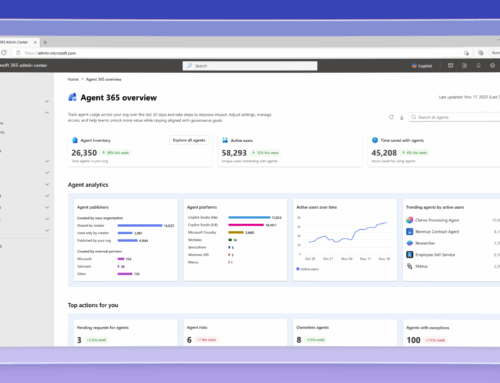In today’s evolving digital workspace, managing content effectively and securely while enhancing collaboration is crucial for businesses. Admittedly, in my 12+ years as a SharePoint consultant, I’ve never paid much attention to the different versions of SharePoint licensing mostly because the solutions I’ve architected or the products we’ve brought to market that utilize SharePoint have never been dependent on “pro” features. However, Microsoft’s new offering, SharePoint Premium, promises to revolutionize content management by leveraging AI and advanced automation, and it has my attention. Today, I’ll explore what SharePoint Premium is and why your organization might need it.
What is SharePoint Premium?
SharePoint Premium is an advanced content management and experiences platform introduced by Microsoft. It evolves from Microsoft Syntex and combines AI-driven solutions to enhance content management, automate workflows at scale, and prepare content for AI functionalities like Microsoft Copilot.
Key Features of SharePoint Premium
SharePoint Premium is divided into three main categories: content processing, content governance, and content experiences. Each of these categories encompasses various features that enhance the way organizations handle their content.
Content Processing
- Document Processing: This feature reads documents, extracts specific parts, and moves that data into columns in a SharePoint library. It involves training an AI model to recognize different pieces of data. Pre-built options include structured, free-form, and unstructured document processing, which automatically extract information to metadata columns, reducing manual tagging.
- Content Assembly: This is essentially document templating. It allows users to create standardized documents by filling out fields in a template. This ensures consistency and structure, particularly useful for documents like contracts or invoices.
- Image Tagging: Uses AI to analyze images and add tags for different objects or components found within them. This is particularly useful for managing large image libraries.
- Taxonomy Tagging: Compares document content to managed metadata terms in your term store, automatically adding matching terms to metadata fields. This ensures precision and accuracy based on structured approaches.
- Autofill Columns: This feature uses AI prompts to fill in gaps not covered by taxonomy tagging, handling various column types like yes/no, choice, or single line of text.
- Document Translation: Automatically translates documents between languages, which is essential for global organizations.
- E-Signature: Integrates with services like Adobe Sign and DocuSign for document signing within SharePoint. This eliminates the need for third-party services and ensures all processes remain within the SharePoint ecosystem.
- OCR (Optical Character Recognition): Extracts text from images and PDFs, making them searchable and ensuring compliance by recognizing and protecting sensitive information.
- Advanced File Viewer and Annotations: Allows viewing and annotating files within SharePoint. Annotations are stored alongside the document, centralizing all related information.
- Content Query: This licensed feature allows for advanced filtering of document libraries based on metadata fields.
- Merging and Extracting PDFs: Combine multiple PDFs or extract specific pages into separate PDFs, simplifying document management.
- Processing Rules: Automate actions based on triggers, such as moving files, sending notifications, or translating documents. This is similar to the classic content organizer but more advanced.
- Premium Taxonomy Features: Allows importing taxonomies in formats like SKOS into the term store, providing more flexibility in managing metadata.
Content Governance
- SharePoint Advanced Management (SAM) License: Includes advanced management features in the SharePoint admin center, like restricted access control, site access policies, and detailed reporting. This license is crucial for configuring governance policies and monitoring admin activities.
- Lifecycle Management: Features like inactivity policies and admin activity logs help manage the lifecycle of SharePoint sites. Actions like archiving or deleting inactive sites ensure compliance and efficient data management.
- SharePoint Backup: Allows configuring backups for SharePoint, OneDrive, and Exchange, ensuring data protection and recovery.
- M365 Archive: Helps save storage costs while keeping data accessible. This feature is useful for retaining important information without active use.
- Advanced Tenant Rename: Enables renaming larger tenants, accommodating environments with more than 10,000 sites and OneDrive accounts.
Content Experiences
- SharePoint Embedded: A headless version of SharePoint for creating custom user interfaces while using SharePoint as backend storage. This is beneficial for third-party vendors or software developers who need a custom interface but want to keep data within M365 for compliance.
- Teams Apps: New Teams apps, like the Agreements app, help manage important documents like contracts within Teams. These apps provide advanced insights and functionality for high-value documents, ensuring quick access and management.
Why Do You Need SharePoint Premium?
Is SharePoint Premium Right for My Organization?
Enabling SharePoint Premium could be a strategic move for your organization, enhancing your content management, security, and collaboration capabilities. I’m in favor of all things AI-driven in 2024 and the automation, advanced compliance tools, and seamless integration with Microsoft Teams will absolutely streamline business processes, improve productivity, and ensure data protection. I view the investment in SharePoint Premium as not just an investment in new technology but also future proofing your organization’s content management system. The investment isn’t as straight forward as you might hope, but I’ll share more on that in a follow-up blog.
If you’re ready to explore these premium features or if your organization needs guidance, our team of experienced Microsoft SharePoint Consultants are here to help. Reach out today to Cathy Ashbaugh, cashbaugh@compass365.com to schedule a complimentary consultation.
For more details on the topics discussed in this blog, you can explore Microsoft’s official SharePoint Premium page or the Microsoft Adoption site.
Compass365, a Microsoft Gold Partner, delivers Microsoft 365 based solutions that help IT and Business leaders improve the way their organizations operate and how their employees work.
Subscribe
Join over 5,000 business and IT professionals who receive our monthly newsletter with the latest Microsoft 365 tips, news, and updates.









